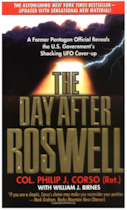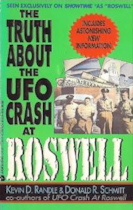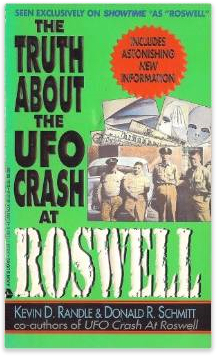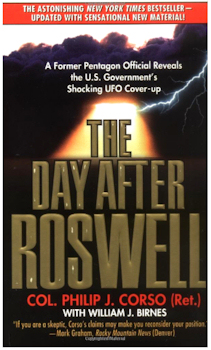  |
These two books claim to tell us "The Truth About Roswell." But do they? A compelling tale from Randle and Schmidt and either a stunning confirmation or clever disinformation from Colonel Corso.
|
|
The Truth About the UFO Crash at Roswell
by Kevin D. Randle and Donald R. Schmidt
Reviewed by Theresa Welsh
 If you're interested in alternate history, sooner or later you have to deal with Roswell and the aliens. This is a well-researched book that looks critically at the famous incident, making a case that real aliens crashed in a real flying saucer near Roswell in 1947. If you're interested in alternate history, sooner or later you have to deal with Roswell and the aliens. This is a well-researched book that looks critically at the famous incident, making a case that real aliens crashed in a real flying saucer near Roswell in 1947.
Government is Covering Up ... What?
It seems clear that something happened that the US government covered up, but the question as to why is still open. Is it really because the government knew this craft was not from our earth and feared people would panic if they knew? According to this book, there was not only a downed craft, but also bodies and one live alien who lived for a while before dying. The people who had contact with either the craft, the debris, or the alien bodies were intimidated into keeping quiet, some threatened with death if they talked.
The remains of the craft and scattered pieces left in the desert were carefully picked up by a military team and taken to Wright Air Force Base in Ohio (now Wright-Patterson), according to this account. The authors interviewed eyewitnesses who were finally willing to talk since they are old and the threats are fifty years in the past. Not everyone wants to take a secret to their grave. But the trail is going cold and those who may know the truth are dying off.
We’re left with second-hand stories and what government documents can be pried loose through the Freedom of Information Act. What actually happened on that stormy night in the desert in July of 1947? Did lightening bring down a “flying saucer” operated by aliens who were spying on our military installations at White Sands or Alamagordo? Nearby, the atomic bomb had been developed and tested. Were they on a mission to see what new weapons we were building when their craft succumbed to an act of nature?
Do our Presidents Know the Truth?
I reserve judgement on the whole thing, but if you want to know more than you got from that hoky TV movie “Roswell” with Martin Sheen, then read this book and draw your own conclusions. Has every president since Truman known the truth and deliberately kept it a secret? Only President Reagan ever gave a hint that there could be an alient threat, when he made remarks that the Soviets and the US would find common interest if the earth were threatened from outside. That's pretty oblique, but he was the president who initiated SDI ("star wars"), an ambitous defense program that seemed like overkill. Was he worried about an alien invasion?
Can We Believe the Latest Government Explanation?
Keep in mind that even the most convincing case (and Randle and Schmidt are pretty convincing) that the Roswell craft was of unknown origin and possessed technology not of this earth does not tell us much about the bigger question: Who are the beings that controlled the craft and what do they want from us?
We haven't a lot of honesty from our government about Roswell, although the government finally repudiated the "weather balloon" explanation, admitting it was a cover story. But government officials then claimed the crash involved another type of high-altitude surveillance balloon from Project Mogul. This was a secret project attempting to listen for Soviet atomic bomb tests. This explanation has not convinced many die-hard believers in the alien hypothesis.
Buy The Truth About the Ufo Crash at Roswell at amazon.com.
at amazon.com.
The Day After Roswell
by Col. Philip J. Corso & William Birnes
Reviewed by Theresa Welsh
 Col. Corso’s book takes up where Randall and Schmidt leave off. If we are to believe Corso, the Roswell crash was indeed an alien space craft. He knows this because in the early 1960s, he had charge of a filing cabinet that contained some of the items retrieved from the crash site. What he calls his “nut file” had pieces of strange technology that has since found its way into our lives, and Corso takes plenty of credit for that. This book is an incredible tale of how much of the important technological advances of the last fifty years owe their existence to what the US military supposedly took from the crashed space craft at Roswell. Col. Corso’s book takes up where Randall and Schmidt leave off. If we are to believe Corso, the Roswell crash was indeed an alien space craft. He knows this because in the early 1960s, he had charge of a filing cabinet that contained some of the items retrieved from the crash site. What he calls his “nut file” had pieces of strange technology that has since found its way into our lives, and Corso takes plenty of credit for that. This book is an incredible tale of how much of the important technological advances of the last fifty years owe their existence to what the US military supposedly took from the crashed space craft at Roswell.
Technology Breakthroughs of the Last 65 Years:
From Aliens? NOOOO!!!!
I read with amazement about how night vision goggles were developed from the eye pieces used by the aliens, and was agog at the thought that fiber optics were straight from the Roswell craft, but I had trouble accepting that microchips, those silicon wafers that are the guts of our computer technology, could have come about because silicon chips containing tiny circuits were found in the crashed vehicle. I have personally written a book about the early days of microcomputers and I know how many people contributed to making the computer industry what it is today. No, I wasn’t part of the development of the transister or the making of the Intel 4004, the first real microprocessor, but I just don’t want to believe those breakthroughs came from aliens!
Corso’s story is a bit like the ancient astronaut theme, but updated. These “astronauts” arrived, not in ancient times, but in 1947. And instead of them being treated as “gods” who benevolently gave us the gifts of technology, we instead wrested these secrets from their crumpled craft as they lay dying in the early morning hours of July 3 (or was it July 4? The reports of this incident don’t even agree on the date).
The Pentagon Doled Out Roswell Technology
According to Corso, the Foreign Technology Desk at the Pentagon, where he worked under General Arthur Trudeau, controlled a cache of Roswell material. Corso gives himself credit for coming up with the idea of feeding out information about these items to other military organizations and defense contractors who had projects going that would be a fit with a Roswell item. For instance, he claims that Bell Labs had some help developing the first junction transistor in 1948. Of course their researchers were already looking for something to replace the clunky and unreliable vacuum tubes, so getting a piece of alien technology just helped them do it faster. Transistor radios, those tiny shirt-pocket versions of what had been a huge living room piece of furniture, became all the rage in the 1950s, and transistors made possible the modern computer industry. It took a bit longer for the microchips in modern computers to come along and replace mainframes with small laptops, but Corso says we owe it all to the aliens.
Other technology to come from the Roswell finds were the laser, the anti-missile missile, and Ronald Reagan’s “Star Wars” technology, which was actually intended to defend us against the aliens. Much of the demand for weapons during the Cold War used the Soviet threat as a cover for the real threat -- from extraterrestrials. I found the degree of paranoia about the Soviets and KGB from that era to be way beyond anything I could have imagined. In Corso’s view of the US government, Soviet spies were everywhere. No one could be trusted. The Roswell cover-up had many layers, but he makes contradictory statements about who actually knew about it. In the beginning, he implies only the select group assembled under Truman’s watch (and it’s the same bunch of people listed in other books on the UFO cover-up) had all the facts, but bits of information and pieces of debris apparently filtered out over the years. He does not claim to have been the only one in possession of Roswell artifacts.
Where Else Could This Story Have Come From?
Is Corso telling the truth? I searched some UFO web sites for information and read many of the more than 140 reviews on Amazon\and find a lot of skepticism, including people who say the book has some basic names and dates wrong. Corso was 82 years old when he wrote this (he is now deceased) and his co-author, William J.Birnes, could have misinterpreted the ramblings of an aged Colonel Corso or simply helped him “remember” some of this. Or Birnes could have made it all up and used an old man with a distinguished military career as a cover for an interesting yarn about the origins of modern technology. Another theory is that Corso wanted his career to be remembered, that he felt he had been in on some big moments in history, and wanted to leave a legacy. Maybe it really happened as he says, or at least the filing cabinet with the artifacts really existed. For me, that’s the heart of the matter. Did that filing cabinet with the pieces of fiber optic cable, night vision eye-pieces, and silicon wafers actually exist?
The most interesting ideas I got from this book is Corso’s contention that the aliens (or “EBE’s” as he calls them) were genetically-created beings designed for deep-space travel and that their tight-fitting suits were actually part of the propulsion system, which involved an electromagnetic field that used the skin of the craft and the skin-like suits of the beings. His description of them is the pretty-standard four-foot tall, big-headed, almond-eyed entities. He makes no speculation about where they came from.
The stories in this book are really difficult to sort out -- I wish Corso had told us why he decided to write this book. That was what bothered me the most as I read this incredible tale. Why would a man trained to secrecy, who had served his country in very high and sensitive places, suddenly reveal what he had spent his life concealing? Was it the same impulse that has led others to "tell all" right before they die? Or was Col. Corso making one last act of service to his country by feeding the public a monumental story of government-concocted disinformation?
NOTE: Philip Corso died in 1998, but his co-author, William J. Birnes, is still out there.
Buy The Day After Roswell at amazon.com.
at amazon.com.
| 






